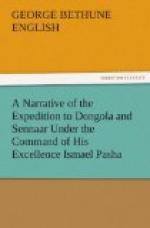The people of Bokki are a hardy race of mountaineers—tall, stout, and handsome. They are Pagans, worshippers of the sun, which planet they consider it as profane to look at. The prisoners brought in by Cogia Achmet resembled in their dress the savages of America; they were almost covered with beads, bracelets, and trinkets, made out of pebbles, bones, and ivory. Their complexion is almost black, and their manners and deportment prepossessing. The arms of these people gave me great surprise: they consisted of well-formed and handsome helmets of iron, coats of mail, made of leather and overlaid with plates of iron, long and well fashioned lances, and a hand-weapon exactly resembling the ancient bills formerly used in England by the yeomanry. They were represented to me by the Turks as dangerous in personal combat. They had never seen fire-arms before, and they nevertheless withstood them with great intrepidity. They said, I was informed, that a fusee was “a coward’s weapon, who stands at a safe distance from his enemy, and kills him by an invisible stroke."[65]
On the 17th, the courier carrying the information to Cairo of this expedition and its results, embarked in a canja to descend the river as far as Berber, from whence he would proceed by the desert to Egypt. Agreeably to the promise of the Pasha, I accompanied him. We arrived at Nousreddin in Berber in five days and nights. Having the favor of the current, and sixteen oarsmen on board, we descended with great rapidity. The view of the country from the river is not pleasing, as the villages lie almost invariably far off from the river; the country, therefore, has the appearance of being almost uninhabited. We saw great numbers of hippopotami, who, in the night, would lift their heads out of the water at no great distance from the canja. They were sometimes fired at, but without apparent effect. We stopped, during the night, for an hour at Shendi, to leave orders from the Pasha to a small garrison of Turkish troops stationed there.[66] The river Nile, below the point of junction with the great Bahar el Abiud, presents a truly magnificent spectacle.[67] Between Halfya and Shendi, the river is straitened and traverses a deep and gloomy defile formed by high rocky hills, between which the Nile runs dark, deep, and rapidly for about twelve or fifteen miles. On emerging from this defile, the river again spreads itself majestically, and flows between immense plains of herbage, bounded only by the horizon: its banks nearly full, but not yet overflowed. About thirty miles above Nousreddin, we passed the mouth of the Bahar el Iswood (on the eastern shore); it is the last river that empties into the Nile. I estimated it at about two-thirds of a mile broad at its embouchure. The Nile, below the point of junction with this river, is more than two miles from bank to bank, at this season. During the two first days of our voyage, we had some severe squalls and very heavy rains; but after passing the territory of Sennaar, we had a sky almost without a cloud.




